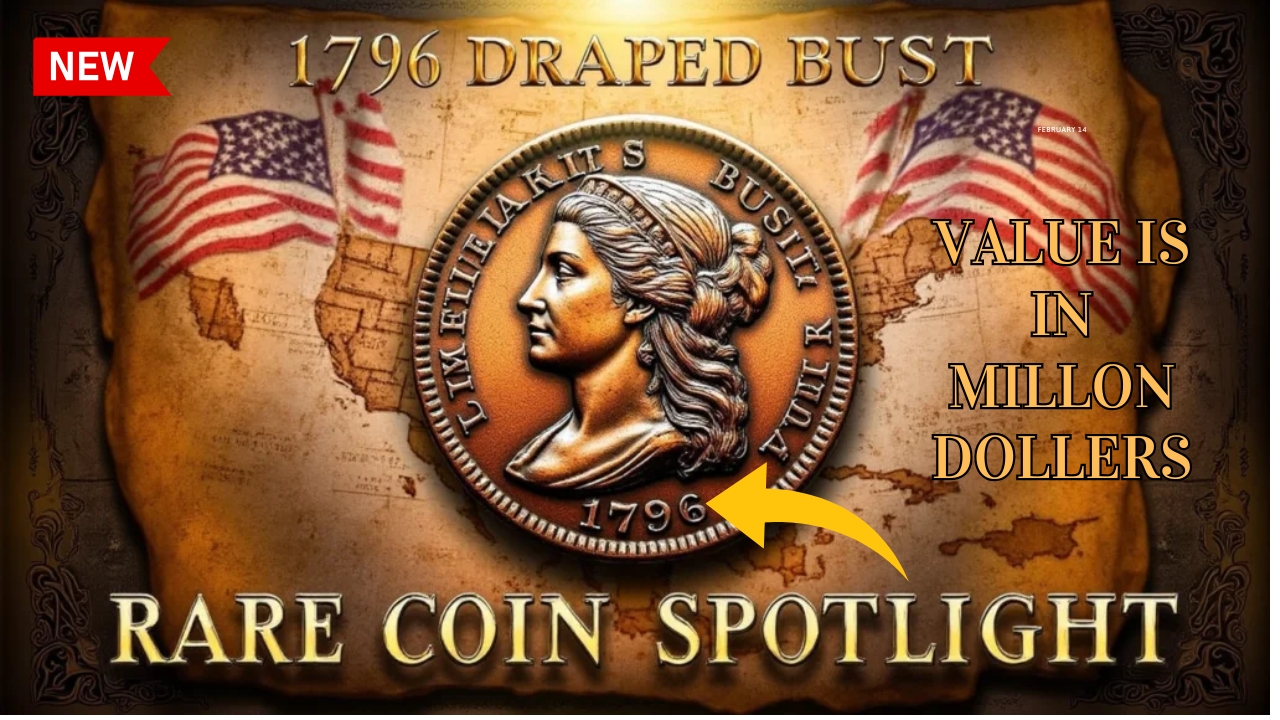1796 Draped Bust Quarter: In the hallowed world of numismatics, few coins capture the imagination quite like the 1796 Draped Bust Quarter. As we stand in 2025, this remarkable piece of American monetary history continues to fascinate collectors,
historians, and investors alike. Its journey from a simple piece of circulating currency to a multi-million-dollar treasure is a testament to the rich tapestry of American economic and cultural evolution.
Historical Context: Birth of a Nation’s Currency
The Early Republic
The year 1796 was a pivotal moment in American history. George Washington was nearing the end of his presidency, the young republic was finding its footing, and the United States Mint in Philadelphia was still in its infancy. Established just three years earlier in 1793, the mint was tasked with creating a standardized currency that would unite the newly formed nation.
Monetary Challenges
In these early days, the United States faced significant challenges in establishing a consistent monetary system. Foreign coins still circulated widely, and the concept of a national currency was still taking shape. The Draped Bust Quarter represented more than just a coin – it was a symbol of national identity and economic independence.
Design and Artistry
The Draped Bust Motif
Designed by Robert Scot, the chief engraver of the United States Mint, the Draped Bust Quarter featured a elegant representation of Liberty. The obverse depicted a right-facing bust of a young woman, her hair flowing, draped in a classical gown – a representation of the young republic’s ideals of freedom and potential.
Reverse Design
The reverse showcased an eagle, a powerful symbol of American independence. Surrounded by a wreath and the inscription “UNITED STATES OF AMERICA,” the design embodied the nascent nation’s aspirations and strength.
Minting Details: A Rare Treasure
Limited Production
In 1796, only 6,146 Draped Bust Quarters were minted. This incredibly low mintage immediately set the stage for the coin’s future rarity. Each coin was struck by hand, using manually operated presses that required immense skill and precision.
Minting Process
The process of creating these quarters was labor-intensive. Dies were hand-carved, and each coin was individually struck. Variations in strike quality, metal composition, and wear make each 1796 Draped Bust Quarter unique.
Numismatic Journey
Early Collector Interest
Initially, these quarters were simply circulating currency. Few people at the time could have imagined the astronomical value these coins would achieve. Many were lost, damaged, or simply worn down through years of use.
Rise in Collectibility
By the mid-20th century, numismatists began to recognize the historical and artistic significance of early American coins. The 1796 Draped Bust Quarter became a holy grail for serious collectors.
Value Trajectory
Market Evolution
The journey of the 1796 Draped Bust Quarter’s value is nothing short of remarkable:
- 1950: $500 – $1,000
- 1980: $50,000 – $100,000
- 2000: $250,000 – $500,000
- 2025: $5,000,000 – $7,500,000
Factors Influencing Value
Several key factors contribute to the coin’s astronomical value:
- Extreme Rarity
- Historical Significance
- Condition
- Provenance
- Collector Demand
Preservation and Authentication
Modern Conservation Techniques
In 2025, preserving such a valuable coin requires cutting-edge technology:
- Non-invasive digital scanning
- Molecular-level analysis
- Advanced environmental control systems
- Blockchain-based provenance tracking
Authentication Challenges
With such high stakes, authentication has become increasingly sophisticated. Advanced spectroscopic analysis, AI-powered image recognition, and comprehensive historical database matching are now standard in verifying the authenticity of such rare coins.
Collector’s Perspective
Investment Potential
Collectors and investors view the 1796 Draped Bust Quarter as more than just a coin. It’s a tangible piece of history, a work of art, and a potentially appreciating asset. Some wealthy collectors view these coins as alternative investments, similar to rare art pieces.
Emotional Connection
Beyond monetary value, these coins represent a connection to America’s early days. Each scratch, each minute detail tells a story of a young nation finding its identity.
Technological Impact on Numismatics
Digital Collecting
The rise of digital technologies has transformed coin collecting:
- Virtual coin museums
- Augmented reality authentication
- Global online auctions
- Fractional ownership platforms
The 1796 Draped Bust Quarter has become a showcase for these technological innovations.
Cultural Significance
Beyond Monetary Value
The coin represents more than just a financial artifact. It’s a symbol of American craftsmanship, resilience, and the intricate journey of a young nation establishing its economic independence.
Future Outlook
Preservation and Research
Ongoing research continues to unveil new insights about these coins. Advanced metallurgical analysis, historical research, and digital preservation techniques ensure that the story of the 1796 Draped Bust Quarter will continue to be told.
Conclusion
As we stand in 2025, the 1796 Draped Bust Quarter remains an enigmatic treasure. Its journey from a simple piece of currency to a multi-million-dollar artifact reflects the dynamic nature of numismatics and the enduring fascination with tangible pieces of history.
More than just a coin, it is a testament to American ingenuity, artistic expression, and the remarkable stories that can be contained within a small piece of metal. Each 1796 Draped Bust Quarter is a time capsule, a work of art, and a bridge connecting us to the earliest days of the United States.
In the words of a renowned numismatist, “These coins are not just collectibles. They are historical narratives, frozen in silver, waiting to tell their stories to those who are willing to listen.”
